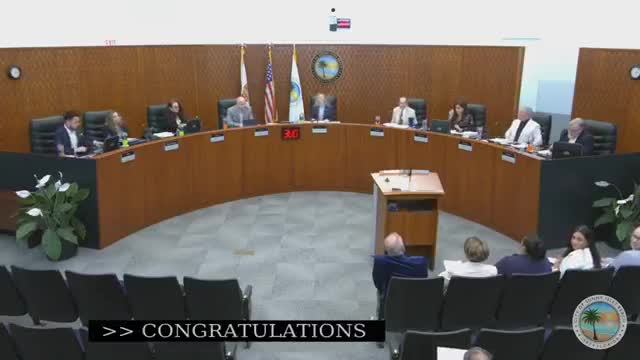Sunny Isles Beach police report 12,235 red‑light citations in six months, propose two new camera sites
March 23, 2025 | City of Sunny Isles Beach, Miami-Dade County, Florida
This article was created by AI summarizing key points discussed. AI makes mistakes, so for full details and context, please refer to the video of the full meeting. Please report any errors so we can fix them. Report an error »

Sunny Isles Beach police reported that their red‑light camera program issued 12,235 notices of violation over a six‑month period and recommended adding two intersections to the system.
The department presented a six‑month recap covering September 2024 through February 2025, saying the program averaged roughly 2,000 notices per month and that repeat violators are a small share of offenders. “This initiative has played a pivotal role in enhancing road and pedestrian safety across our community,” the chief said during the presentation.
The memo to the commission and the presentation included these figures: a six‑month total of 12,235 notices; an average near 2,000 per month; a highest repeat‑violator rate of about 3.4% in the period reviewed; and that about 13.1% of notices over the six months were issued to Sunny Isles Beach residents. As of the presenter’s most recent data point (about two weeks before the meeting), 3,639 notices of violation remained outstanding. In the previous 60 days, staff reported 2,995 notices had been converted to uniform traffic citations and that magistrate hearings were scheduled (three hearings in January 2025 and 11 in February 2025).
On enforcement and penalties, the department said the citation amount is $158, with an additional administrative cost of $150 if the notice proceeds to a hearing. Staff said a formal cost‑benefit analysis is still under way but that current projections indicate revenue from the program covers its operating costs.
Police told the commission there have been no accident reports tied to the cameras during the program period presented. The department recommended expanding the program to two additional locations: 174th Street (Winston Towers, northbound and southbound) and 167th Street at Collins Avenue (northbound and southbound). The chief said the expansions are proposed pending the commission’s and manager’s approval.
Commissioners discussed next steps and expressed general support for the data. “This definitely exceeds my expectations…data works,” Commissioner Viscara said, and asked whether expansion would target specific intersections; the chief confirmed the two locations named. Commissioner Joseph asked whether staff can track repeat violators over time; the chief replied staff cannot identify the same individual across months for repeat‑offender tracking but can continue to measure the share of violations by residents.
The commission did not take a formal recorded vote during the update. Staff said they would return with cost details, and the chief noted the department is prepared to advance program expansion if the commission directs staff to do so.
The department presented a six‑month recap covering September 2024 through February 2025, saying the program averaged roughly 2,000 notices per month and that repeat violators are a small share of offenders. “This initiative has played a pivotal role in enhancing road and pedestrian safety across our community,” the chief said during the presentation.
The memo to the commission and the presentation included these figures: a six‑month total of 12,235 notices; an average near 2,000 per month; a highest repeat‑violator rate of about 3.4% in the period reviewed; and that about 13.1% of notices over the six months were issued to Sunny Isles Beach residents. As of the presenter’s most recent data point (about two weeks before the meeting), 3,639 notices of violation remained outstanding. In the previous 60 days, staff reported 2,995 notices had been converted to uniform traffic citations and that magistrate hearings were scheduled (three hearings in January 2025 and 11 in February 2025).
On enforcement and penalties, the department said the citation amount is $158, with an additional administrative cost of $150 if the notice proceeds to a hearing. Staff said a formal cost‑benefit analysis is still under way but that current projections indicate revenue from the program covers its operating costs.
Police told the commission there have been no accident reports tied to the cameras during the program period presented. The department recommended expanding the program to two additional locations: 174th Street (Winston Towers, northbound and southbound) and 167th Street at Collins Avenue (northbound and southbound). The chief said the expansions are proposed pending the commission’s and manager’s approval.
Commissioners discussed next steps and expressed general support for the data. “This definitely exceeds my expectations…data works,” Commissioner Viscara said, and asked whether expansion would target specific intersections; the chief confirmed the two locations named. Commissioner Joseph asked whether staff can track repeat violators over time; the chief replied staff cannot identify the same individual across months for repeat‑offender tracking but can continue to measure the share of violations by residents.
The commission did not take a formal recorded vote during the update. Staff said they would return with cost details, and the chief noted the department is prepared to advance program expansion if the commission directs staff to do so.
View full meeting
This article is based on a recent meeting—watch the full video and explore the complete transcript for deeper insights into the discussion.
View full meeting